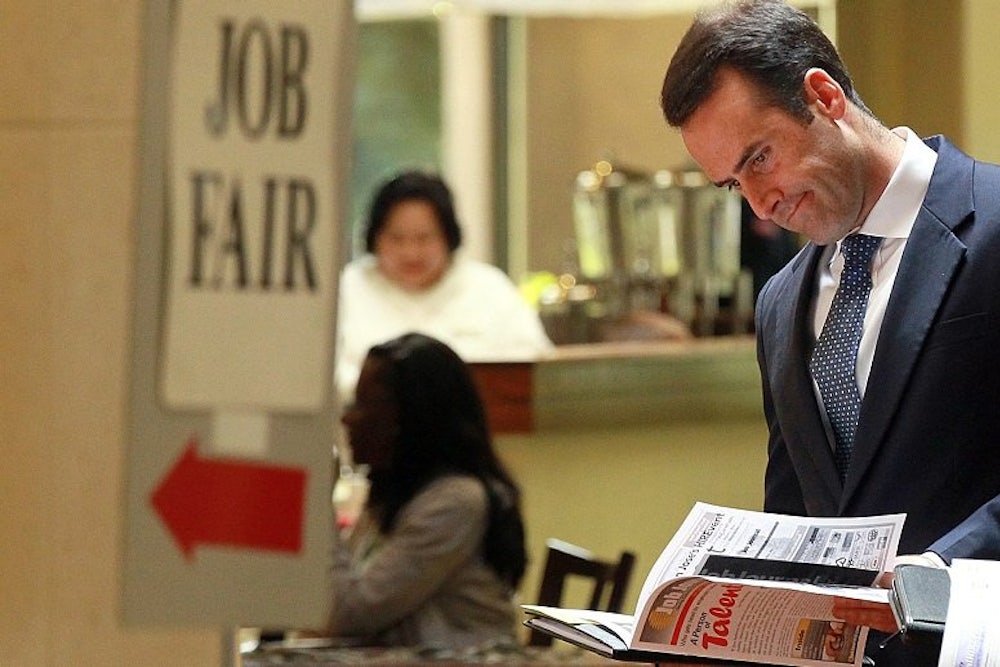The economy is very difficult to understand—and nowhere was that more clear than in the March jobs report, which the Labor Department released Friday morning. The topline numbers are terrible. The economy added just 126,000 jobs in March, far below expectations of 245,000. The unemployment rate remained unchanged at 5.5 percent. And revisions to the January and February reports were -38,000 and -31,000 respectively. That’s not good.
As always, you should take each individual jobs report with a grain of salt. The reports are notoriously noisy. Instead, you should look at the three-month moving average of jobs gains. Before the March report, you could see a clear upwards trend in the jobs report. As I’ve written before, the economy had kicked into second gear. But with Friday’s weak report, that no longer looks like it’s the case:

What’s even more interesting in this report is that wage growth actually beat expectations, rising 0.3 percent in March versus the expected 0.2 percent. In the past year, wages have grown 2.0 percent. That’s only a slight beat and can be attributed to the noisy report. Yet it’s still tough to square a slight increase in wages with the ugly jobs numbers. It’s a complete reversal of the narrative that we’ve seen over the past year where the jobs numbers repeatedly came in above 200,000 yet wage growth was muted. Simply put, it doesn’t make any sense!
Here’s the good news: It really is just one report and we shouldn’t freak out over it. Outliers happen, sometimes even large ones. Yet, policymakers shouldn’t ignore this either. The downward revisions are not a good sign and the labor force participation rate also dropped from 62.8 percent to 62.7 percent. Again, the participation rate fluctuates; it has generally been right around 62.7 percent for almost two years now.
There was some other good news in the rest of the report as well. A more expansive measure of the unemployment rate that includes part-time workers and workers who are too discouraged to search for work fell from 11.0 percent to 10.9 percent. And the number of long-term unemployed declined from 2.71 million to 2.56—a significant drop.
This report becomes more concerning if you factor in other recent economic data. U.S. manufacturing has slowed for five months in a row, retail sales declined 0.6 percent in February, and GDP growth in the final quarter of 2014 was revised to a seasonally-adjusted rate of 2.2 percent, below expectations of 2.4 percent. In other words, economists were already fearful that the economy had faced a setback. The March jobs report will only add to that trepidation.
What does this mean for policymakers? Most importantly, it should reinforce the need for the Federal Reserve to show patience in raising interest rates above zero. Many economists think that first rate hike could come as early as June. But that would be a mistake. The underlying economic data has been weak, inflation is still muted and the downside risks that economy could slow are growing. Fed Chair Janet Yellen, for instance, has said that the strengthening of the dollar could hurt exports. Meanwhile, the Eurozone is still on edge as Greece tries to work out a deal with its creditors and the Middle East is increasingly unstable as Yemen borders on the brink of a civil war.
All of this sounds pretty negative for the economy. Still, it’s important to not get too pessimistic. The U.S. economy has a lot going for it right now. Gas prices are still low. Job growth, with the exception of this report, has been strong. And we’re already seeing anecdotal evidence that the tightening labor market has required employers to raise their wages. On Wednesday, McDonald’s was the latest company to make such a move.
In fact, it seems far likelier that we’re on the brink of widespread wage growth for millions of Americans than an economic slowdown. In other words, this report may look bad—and it is bad—but it’s not necessarily an accurate representation of the economy. If the data continues to come in poorly in the spring and summer, then policymakers should become much more concerned. But right now, it's nowhere near time to panic.
This post has been updated.
